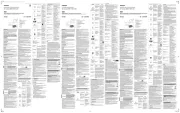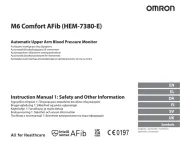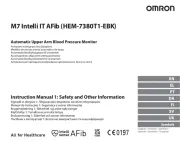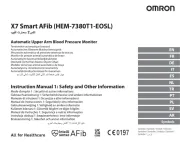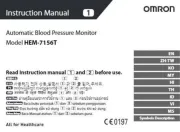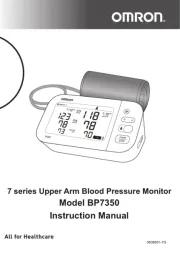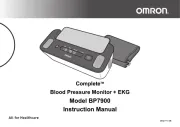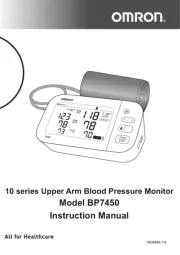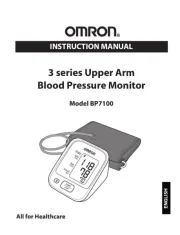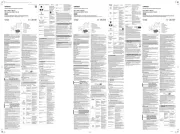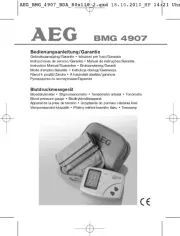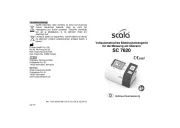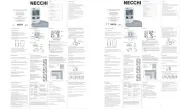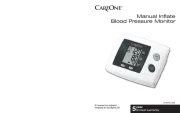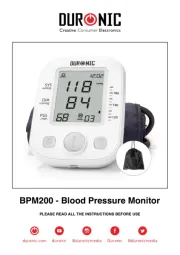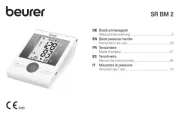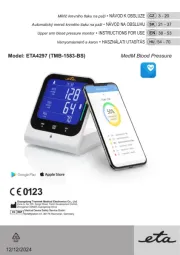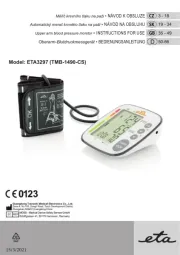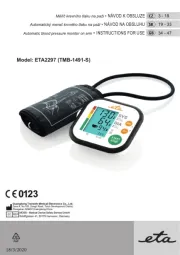
Thank you for purchasing the OMRON Automatic Upper Arm Blood
Pressure Monitor. This blood pressure monitor uses the oscillometric
method of blood pressure measurement. This means this monitor
detects your blood movement through your brachial artery and
converts the movements into a digital reading.
This instruction manual provides you with important information
about the OMRON Automatic Upper Arm Blood Pressure Monitor. To
ensure the safe and proper use of this monitor, READ and
UNDERSTAND all of these instructions. If you do not understand
these instructions or have any questions, contact your OMRON
retail outlet or distributor before attempting to use this monitor.
For specific information about your own blood pressure, consult
This device is a digital monitor intended for use in measuring blood
pressure and pulse rate in adult patient population. The device
detects the appearance of irregular heartbeats during measurement
and indicates this via a symbol with the measurement result.
Adult population (may include patients themselves) who can
understand this instruction manual.
Patient’s blood pressure can be measured non-invasively and simply
This monitor is intended to be multiple patient multiple use.
Patient’s arm circumference must be 17 - 42 cm.
This device is used by healthy individuals, patients with hypertension,
patients with health-conscious individuals, in a general household
situation for measuring blood pressure and pulse rate.
Remove this monitor and other components from the packaging and
inspect for damage. If this monitor or any other components is
damaged, DO NOT USE and consult with your OMRON retail outlet or
Read the Important Safety Information in this instruction manual
before using this monitor. Follow this instruction manual thoroughly
Keep for future reference. For specific information about your own
blood pressure, consult with your physician.
• DO NOT use this monitor on an injured arm or an arm under
• DO NOT apply the arm cuff on your arm while on an intravenous
drip or blood transfusion.
• DO NOT use this monitor on infants, toddlers, children or persons
who cannot express themselves.
• Taking measurements more often than necessary may cause
bruising due to blood flow interference.
• Inflating to a higher pressure than necessary may result in bruising
of the arm where the cuff is applied. NOTE: refer to “If your systolic
pressure is more than 210 mmHg” in the end of instruction manual
2 for additional information.
• Stop using this monitor and consult with your physician if you
experience skin irritation or discomfort.
Indicates a potentially hazardous
situation which, if not avoided, could
result in death or serious injury.
• DO NOT adjust medication (including altering your use of any drug
or treatment) based on readings from this blood pressure monitor.
Take medication as prescribed by your physician. ONLY a physician
is qualified to diagnose and treat high blood pressure and heart
• NEVER diagnose or treat yourself based on your readings. ALWAYS
consult with your physician.
• If you are experiencing any symptoms or concerns, consult with
• DO NOT postpone/stop regular checkups or physician visits based
on the results that you are getting from this monitor.
• DO NOT use this monitor in areas containing high frequency (HF)
surgical equipment, magnetic resonance imaging (MRI)
equipment, computerized tomography (CT) scanners. This may
result in incorrect operation of the monitor and/or cause an
• DO NOT use this monitor in oxygen rich environments or near
• Consult with your physician before using this monitor if you have
common arrhythmias such as atrial or ventricular premature beats
or atrial fibrillation; arterial sclerosis; poor perfusion; diabetes;
pregnancy; pre-eclampsia or renal disease. NOTE that any of these
conditions in addition to patient motion, trembling, or shivering
may affect the measurement reading.
• To help avoid strangulation, keep the air tube and AC adapter cable
away from infants, toddlers and children.
• This product contains small parts that may cause a choking hazard
if swallowed by infants, toddlers and children.
AC Adapter (optional accessory) Handling and Usage
• DO NOT use the AC adapter if this monitor or the AC adapter cable
is damaged. If this monitor or the cable is damaged, turn off the
power and unplug the AC adapter immediately.
• Plug the AC adapter into the appropriate voltage outlet. DO NOT
use in a multi-outlet plug.
• NEVER plug in or unplug the AC adapter from the electric outlet
• DO NOT disassemble or attempt to repair the AC adapter.
Battery Handling and Usage
• Keep the batteries out of the reach of infants, toddlers and children.
Indicates a potentially hazardous
situation which, if not avoided, may
result in minor or moderate injury
to the user or patient, or cause
damage to the equipment or other
• Consult with your physician before using this monitor on an arm
where intravascular access or therapy, or an arterio-venous (A-V)
shunt, is present because of temporary interference to blood flow
and could result in injury.
• Consult with your physician before using this monitor if you have
had a mastectomy or lymph node clearance.
• Consult with your physician before using this monitor if you have
severe blood flow problems or blood disorders as cuff inflation can
• ONLY inflate the arm cuff when it is applied on your upper arm.
• Remove the arm cuff if it does not start deflating during a
• DO NOT use this monitor for any purpose other than measuring
• During measurement, make sure that no mobile device or any
other electrical device that emits electromagnetic fields is within
30 cm of this monitor. This may result in incorrect operation of the
monitor and/or cause an inaccurate reading.
• DO NOT disassemble or attempt to repair this monitor or other
components. This may cause an inaccurate reading.
• DO NOT use in a location where there is moisture or a risk of water
splashing this monitor. This may damage this monitor.
• DO NOT use this monitor in a moving vehicle such as in a car or on
• DO NOT drop or subject this monitor to strong shocks or vibrations.
• DO NOT use this monitor in places with high or low humidity or
high or low temperatures. Refer to section 4.
• During measurement, observe the arm to ensure that the monitor
is not causing prolonged impairment to blood circulation.
• DO NOT use this monitor with other medical electrical (ME)
equipment simultaneously. This may result in incorrect operation
of the devices and/or cause an inaccurate reading.
• Avoid bathing, drinking alcohol or caffeine, smoking, exercising
and eating for at least 30 minutes before taking a measurement.
• Rest for at least 5 minutes before taking a measurement.
• Remove tight-fitting or thick clothing from your arm while taking a
• Remain still and DO NOT talk while taking a measurement.
• ONLY use the arm cuff on persons whose arm circumference is
within the specified range of the cuff.
• Ensure that this monitor has acclimated to room temperature
before taking a measurement. Taking a measurement after an
extreme temperature change could lead to an inaccurate reading.
It is recommended that you wait for approximately 2 hours for the
monitor to warm up or cool down when the monitor is used in an
environment within the temperature specified as operating
conditions after it is stored either at the maximum or at the
minimum storage temperature. For additional information on
operating and storage / transport temperature, refer to section 4.
• DO NOT use this monitor after the durable period has ended. Refer
• DO NOT crease the arm cuff or the air tube excessively.
• DO NOT fold or kink the air tube while taking a measurement. This
may cause an injury by interrupting blood flow.
• To unplug the air plug, pull on the plastic air plug at the base of the
tube, not the tube itself.
• ONLY use the AC adapter, arm cuff, batteries and accessories
specified for this monitor. Use of unsupported AC adapters, arm
cuffs and batteries may damage and/or may be hazardous to this
• ONLY use the approved arm cuff for this monitor. Use of other arm
cuffs may result in incorrect readings.
• Read and follow the “Correct Disposal of This Product” in section 5
when disposing of the device and any used accessories or optional
AC Adapter (optional accessory) Handling and Usage
• Fully insert the AC adapter into the outlet.
• When unplugging the AC adapter from the outlet, be sure to safely
pull from the AC adapter. DO NOT pull from the AC adapter cable.
• When handling the AC adapter cable:
DO NOT damage it. / DO NOT break it. / DO NOT tamper with it. /
DO NOT pinch it. / DO NOT forcibly bend or pull it. /
DO NOT twist it. / DO NOT use it if it is gathered in a bundle. /
DO NOT place it under heavy objects.
• Wipe any dust off of the AC adapter.
• Unplug the AC adapter when not in use.
• Unplug the AC adapter before wiping this monitor.
Battery Handling and Usage
• DO NOT insert batteries with their polarities incorrectly aligned.
• ONLY use 4 “AA” alkaline or manganese batteries with this monitor.
DO NOT use other types of batteries. DO NOT use new and used
batteries together. DO NOT use different brands of batteries
• Remove the batteries if this monitor will not be used for a long
• If battery fluid should get in your eyes, immediately rinse with
plenty of clean water. Consult with your physician immediately.
• If battery fluid should get on your skin, wash your skin immediately
with plenty of clean, lukewarm water. If irritation, injury or pain
persists, consult with your physician.
• DO NOT use batteries after their expiration date.
• Periodically check the batteries to ensure they are in good working
• To stop a measurement, press the [START/STOP] button while
• When you take a measurement on the right arm, the air tube should
be at the side of your elbow. Be careful not to rest your arm on the
• Blood pressure may differ between the right and left arm, and may
result in a different measurement value. Always use the same arm
for measurements. If the values between both arms differ
substantially, check with your physician on which arm to use for
• When using an optional AC adapter, make sure not to place your
monitor in a location where it is difficult to plug and unplug the
Battery Handling and Usage
• Disposal of used batteries should be carried out in accordance with
• The supplied batteries may have a shorter life span than new
• Replacing batteries will not delete previous readings.
If any of the below problems occur during measurement, check to
make sure that no other electrical device is within 30 cm of the
monitor. If the problem persists, refer to the table below.
Instruction Manual 1: Safety and Other Information
For symbols information, refer to “Symbols Description” section.
M2 Essential (HEM-7188-E)
IM1-HEM-7188-LE/HEM-7188-E-02-11/2024
Automatic Upper Arm Blood Pressure Monitor
(for optional AC adapter)
Important Safety Information
1 Error Messages and Troubleshooting
Display/Problem Possible Cause Solution
Thank you for buying an OMRON product. This product is constructed
of high quality materials and great care has been taken in its
manufacturing. It is designed to give you a high level of comfort,
provided that it is properly operated and maintained as described in
This product is warranted by OMRON for a period of 5 years after the
date of purchase. The proper construction, workmanship and
materials of this product is warranted by OMRON. During this period
of warranty OMRON will, without charge for labour or parts, repair or
replace the defect product or any defective parts.
The warranty does not cover any of the following:
Transport costs and risks of transport.
Costs for repairs and / or defects resulting from repairs done by
Periodic check-ups and maintenance.
Failure or wear of optional parts or other attachments other than
the main device itself, unless explicitly warranted above.
Costs arising due to non-acceptance of a claim (those will be
Damages of any kind including personal caused accidentally or
Calibration service is not included within the warranty.
Optional parts have a one (1) year warranty from date of purchase.
Optional parts include, but are not limited to the following items:
Should warranty service be required please apply to the dealer whom
the product was purchased from or an authorised OMRON distributor.
For the address refer to the product packaging / literature or to your
specialised retailer. If you have difficulties in finding OMRON customer
services, visit our website (www.omron-healthcare.com) for contact
Repair or replacement under the warranty does not give rise to any
extension or renewal of the warranty period.
The warranty will be granted only if the complete product is returned
together with the original invoice / cash ticket issued to the consumer
To protect your monitor from damage, follow the directions below:
Changes or modifications not approved by the manufacturer will void
DO NOT disassemble or attempt to repair this monitor or other
components. This may cause an inaccurate reading.
• Store your monitor and other components in a clean, safe location.
• Gently fold the air tube into the arm cuff. Note: Do not bend or
crease the air tube excessively.
• Do not store your monitor and other components:
- If your monitor and other components are wet.
- In locations exposed to extreme temperatures, humidity, direct
sunlight, dust or corrosive vapors such as bleach.
- In locations exposed to vibrations or shocks.
• Do not use any abrasive or volatile cleaners.
• Use a soft dry cloth or a soft cloth moistened with mild (neutral)
detergent to wipe your monitor and arm cuff, and then wipe them
• Do not wash or immerse your monitor and arm cuff or other
• Do not use gasoline, thinners or similar solvents to wipe your
monitor and arm cuff or other components.
3.4 Calibration and Service
• The accuracy of this blood pressure monitor has been carefully
tested and is designed for a long service life.
• It is generally recommended to have the unit inspected every two
years to ensure correct functioning and accuracy. Please consult
your authorised OMRON dealer or the OMRON Customer Service at
the address given on the packaging or attached literature.
• These specifications are subject to change without notice.
• This monitor is clinically investigated according to the
requirements of EN ISO 81060-2:2014 and complies with
EN ISO 81060-2:2019+A1:2020+A2:2024 (excluding pregnant and
pre-eclampsia patients). In the clinical validation study, K5 was
used on 85 subjects for determination of diastolic blood pressure.
• IP classification is degrees of protection provided by enclosures in
accordance with IEC 60529. This monitor and optional AC adapter
are protected against solid foreign objects of 12.5 mm diameter
and greater such as a finger. The monitor and optional AC adapter
HHP-CM01 and HHP-AM01 are protected against vertically falling
water drops which may cause issues during a normal operation.
The optional AC adapter HHP-BFH01 is protected against oblique
falling water drops which may cause issues during a normal
• Operation mode classification complies with IEC 60601-1.
This device conforms to the EN 60601-1-2:2015+A1:2021
Electromagnetic Compatibility (EMC) standard.
Further documentation in accordance with this EMC standard is
https://healthcare.omron.com/electro-magnetic-compatibility
Refer to the EMC information for this device on the website.
• This OMRON product is produced under the strict quality system of
OMRON HEALTHCARE Co., Ltd., Japan. The Core component for
OMRON blood pressure monitors, which is the Pressure Sensor, is
• Please report to the manufacturer and the competent authority of
the Member State in which you are established about any serious
incident that has occurred in relation to this device.
Blood pressure varies constantly. Many factors
including stress, time of day, and/or how you
apply the arm cuff, may affect your blood
pressure. Review sections 2, 4 and 5 of
Press the [START/STOP] button to turn the
monitor off, then press it again to take a
measurement. If the problem continues,
remove all batteries and wait for 30 seconds.
Then re-install the batteries. If the problem
still persists, contact your OMRON retail outlet
Product Category Electronic Sphygmomanometers
Product description Automatic Upper Arm Blood
Model (Code) M2+ (HEM-7188-LE)/
M2 Essential (HEM-7188-E)
Display LCD digital display
Cuff pressure range 0 to 299 mmHg
Blood pressure measurement
Pulse measurement range 40 to 180 beats / min.
Accuracy Pressure: ±3 mmHg
Pulse: ±5 % of display reading
Measurement method Oscillometric method
Operation mode Continuous operation
IP classification Monitor: IP21
IP21 (HHP-CM01 / HHP-AM01) or
Power source 4 “AA” batteries 1.5 V or optional
AC adapter (INPUT AC 100 - 240 V
50 - 60 Hz 0.12 - 0.065 A)
Battery life Approx. 900 measurements (Using
new alkaline batteries and
included arm cuff. Depending on
the type of battery and arm cuff.)
Durable period (Service life) Monitor: 5 years or the time when
reaching 30000 times of use. /
Cuff: 5 years or the time when
reaching 10000 times of use. /
Optional AC adapter: 5 years
Operating conditions +10 to +40 °C / 15 to 90 % RH
(non-condensing) / 800 to
Storage / Transport conditions -20 to +60 °C / 10 to 90 % RH
Weight Monitor: approx. 260 g
(not including batteries)
Arm cuff for HEM-7188-LE:
Dimensions Monitor: approx. 98 mm (W) ×
Arm cuff for HEM-7188-LE:
(air tube: 750 mm) / Arm cuff for
HEM-7188-E: approx. 146 mm ×
466 mm (air tube: 610 mm)
Cuff circumference applicable
Display/Problem Possible Cause Solution
Memory Stores up to 30 readings
Contents Monitor, arm cuff (HEM-RML31 for
HEM-7188-LE / HEM-CR24 for
HEM-7188-E), 4 “AA” batteries,
Instruction Manual 1 and 2
Protection against electric
Internally powered ME equipment
(when using only batteries)
Class II ME equipment (when
using optional AC adapter)
Applied part Type BF (arm cuff)
5 Correct Disposal of This Product (Waste
Electrical & Electronic Equipment)
This marking shown on the product or its literature,
indicates that it should not be disposed of, with other
household wastes at the end of its working life.
To prevent possible harm to the environment or human
health from uncontrolled waste disposal, please
separate this product from other types of wastes and
recycle it responsibly to promote the sustainable reuse
Household users should contact either the retailer where they
purchased this product, or their local government office, for details
of where and how they can return this item for environmentally safe
Business users should contact their supplier and check the terms and
conditions of the purchase contract. This product should not be
mixed with other commercial waste for disposal.
6 Important Information regarding
Electromagnetic Compatibility (EMC)
7 Guidance and Manufacturer’s
Merci d’avoir fait l’acquisition du tensiomètre automatique brassard
OMRON. Ce tensiomètre fonctionne sur le principe de l’oscillométrie
pour mesurer votre pression artérielle. Cela signifie qu’il détecte la
circulation de votre sang dans l’artère brachiale et la convertit en une
Ce mode d’emploi vous fournit des informations importantes sur le
tensiomètre automatique brassard OMRON. Pour une utilisation sûre
et correcte de ce tensiomètre, LIRE et COMPRENDRE toutes ces
instructions. Si vous ne comprenez pas ces instructions ou avez
des questions, contactez votre détaillant ou votre revendeur
OMRON avant d’essayer d’utiliser ce tensiomètre. Pour des
informations spécifiques sur votre propre pression artérielle,
Ce tensiomètre numérique est conçu pour mesurer la pression
artérielle et le pouls chez les patients adultes. L’appareil détecte les
pulsations cardiaques irrégulières pendant la mesure et l’indique par
le biais d’un symbole accompagnant le résultat de la mesure.
Population de patients adultes
Population adulte (y compris les patients eux-mêmes) capable de
comprendre ce mode d’emploi.
La pression artérielle du patient peut être mesurée de manière non
invasive et simple à domicile.
Ce tensiomètre est destiné à un usage multiple par plusieurs patients.
La circonférence du bras du patient doit être comprise entre
Cet appareil est utilisé par des personnes en bonne santé, des patients
souffrant d’hypertension, des patients soucieux de leur santé, dans un
cadre domestique général, pour mesurer la pression artérielle et le
Retirer le tensiomètre et les autres composants de l’emballage et
vérifier qu’ils ne sont pas endommagés. Si le tensiomètre ou tout
autre composant est endommagé, NE PAS L’UTILISER et consulter un
détaillant ou un revendeur OMRON.
Lire les informations importantes sur la sécurité dans ce mode
d’emploi avant d’utiliser ce tensiomètre. Suivre attentivement le
présent mode d’emploi pour votre sécurité.
Le conserver pour s’y référer ultérieurement. Pour des informations
spécifiques sur votre propre pression artérielle, consultez votre
• NE PAS utiliser ce tensiomètre sur un bras blessé ou placé sous
• NE PAS porter le brassard sur le bras dans lequel une perfusion ou
une transfusion de sang est en cours.
• NE PAS utiliser ce tensiomètre sur des nourrissons, des tout-petits,
des enfants ou des personnes qui ne peuvent pas s’exprimer.
• La prise de mesures plus souvent que nécessaire peut provoquer
des ecchymoses consécutives aux interférences avec le flux
• Le gonflage du brassard à une pression plus élevée que nécessaire
peut provoquer des ecchymoses sur le bras à l’endroit où le
brassard est posé. REMARQUE : se reporter à l’encadré « Si votre
pression systolique est supérieure à 210 mmHg » à la fin du mode
d’emploi 2 pour plus d’informations.
• Arrêter d’utiliser ce tensiomètre et consulter votre médecin en cas
d’irritation cutanée ou de gêne.
potentiellement dangereuse qui,
si elle n’est pas évitée, peut
entraîner la mort ou de graves
• NE PAS ajuster le traitement (y compris modifier l’utilisation d’un
médicament ou d’un traitement) sur la base des relevés de ce
tensiomètre. Suivre le traitement prescrit par votre médecin. SEUL
un médecin est qualifié pour diagnostiquer et traiter l’hypertension
et des problèmes cardiaques.
• Ne JAMAIS poser un diagnostic ou vous traiter vous-même sur la
base des mesures réalisées. TOUJOURS consulter un médecin.
• Si vous ressentez un symptôme ou éprouvez une inquiétude
quelconque, consultez votre médecin.
• NE PAS reporter/arrêter les contrôles réguliers ou les visites chez le
médecin en fonction des résultats que vous fournit ce moniteur.
• NE PAS utiliser ce tensiomètre dans des lieux contenant des
équipements chirurgicaux à haute fréquence (HF), d’imagerie par
résonance magnétique (IRM) ou de tomodensitométrie (CT). Cela
risquerait de perturber le fonctionnement du moniteur et/ou de
provoquer des erreurs de mesure.
• NE PAS utiliser ce tensiomètre dans des environnements riches en
oxygène ou à proximité de gaz inflammables.
• Consulter votre médecin avant d’utiliser ce tensiomètre dans l’une
des conditions suivantes : arythmies courantes telles
qu’extrasystoles auriculaires ou ventriculaires ; fibrillation
auriculaire ; artériosclérose ; mauvaise perfusion ; diabète ;
grossesse ; pré-éclampsie ou maladie rénale. NOTEZ que toutes ces
conditions, en plus des mouvements, tremblements ou frissons du
patient peuvent avoir un impact sur la mesure.
• Pour éviter tout risque de strangulation, conserver le tuyau à air et
le câble de l’adaptateur secteur hors de portée des bébés et des
• Ce produit contient des petites pièces pouvant présenter un risque
d’étouffement en cas d’ingestion par des bébés et des enfants.
Manipulation et utilisation de l’adaptateur secteur
• NE PAS utiliser l’adaptateur secteur si le tensiomètre ou le câble de
l’adaptateur secteur est endommagé. Si le tensiomètre ou le câble
de l’adaptateur secteur est endommagé, éteindre l’appareil et
débrancher l’adaptateur secteur immédiatement.
• Brancher l’adaptateur secteur sur la prise de tension appropriée. NE
PAS utiliser avec une multiprise.
• NE JAMAIS brancher ou débrancher l’adaptateur secteur de la prise
électrique avec les mains mouillées.
• NE PAS démonter ou tenter de réparer l’adaptateur secteur.
Manipulation et utilisation de la pile
• Garder les piles hors de la portée des bébés et des enfants.
Indique une situation potentiellement
dangereuse qui, si elle n’est pas évitée,
peut entraîner des blessures mineures
ou modérées chez l’utilisateur ou le
patient, ou endommager l’appareil ou
• Consulter votre médecin avant d’utiliser ce tensiomètre sur un bras
muni d’une perfusion intravasculaire ou sous traitement
intravasculaire, ou pourvu d’une anastomose artérioveineuse en
raison d’interférences temporaires avec le flux sanguin et du risque
• Si une mastectomie ou une ablation de ganglion lymphatique a été
subie, consulter un médecin avant d’utiliser ce tensiomètre.
• Consulter votre médecin avant d’utiliser ce tensiomètre si vous êtes
atteint de graves problèmes de circulation sanguine ou de troubles
sanguins car le gonflage du brassard peut causer des ecchymoses.
• NE gonfler le brassard QUE lorsqu’il enroulé autour de votre bras.
• Retirer le brassard s’il ne commence pas à se dégonfler lors d’une
• NE PAS utiliser ce tensiomètre dans d’autres buts que la mesure de
• Pendant la mesure, veiller à ce qu’aucun appareil mobile ou autre
appareil électrique émettant des champs électromagnétiques ne
se trouve dans un rayon de 30 cm de ce moniteur. Cela risquerait de
perturber le fonctionnement du moniteur et/ou de provoquer des
• NE PAS démonter ou tenter de réparer le tensiomètre ou d’autres
composants. Cela pourrait compromettre la précision de lecture.
• NE PAS utiliser le tensiomètre dans un endroit humide ou dans
lequel il pourrait être éclaboussé par de l’eau. Cela risque de
• NE PAS utiliser ce tensiomètre dans un véhicule en mouvement,
comme une voiture ou un avion.
• NE PAS laisser tomber le tensiomètre ou le soumettre à des
vibrations ou chocs violents.
• NE PAS utiliser ce tensiomètre dans des endroits présentant une
humidité élevée ou faible, ou des températures élevées ou basses.
Se reporter à la section 4.
• Pendant la mesure, observer le bras pour vérifier que le tensiomètre
ne provoque pas une altération prolongée de la circulation sanguine.
• NE PAS utiliser ce tensiomètre en même temps qu’un autre
équipement médical électrique. Cela risquerait de perturber le
fonctionnement des appareils et/ou de provoquer des erreurs de
• Éviter de prendre un bain, de consommer de l’alcool ou de la
caféine, de fumer ou de faire du sport 30 minutes avant la mesure.
• Se reposer pendant au moins 5 minutes avant la mesure.
• Retirer les vêtements moulants ou épais de votre bras lorsque vous
• Rester immobile et NE PAS parler pendant la mesure.
• N’utiliser le brassard QUE sur des personnes dont la circonférence
du bras se situe dans la plage spécifiée du brassard.
• Veillez à ce que le tensiomètre ait atteint la température ambiante
avant d’effectuer une mesure. Toute mesure réalisée après un
changement de température extrême pourrait fournir un résultat
incorrect. Il est recommandé d’attendre environ 2 heures pour que
le tensiomètre se réchauffe ou se refroidisse lorsqu’il est utilisé dans
un environnement dont la température se situe dans la plage des
températures indiquées comme températures de fonctionnement,
après qu’il a été conservé à la température de stockage maximum
ou minimum. Pour plus d’informations sur la température de
fonctionnement et de stockage/transport, se reporter à la section 4.
• NE PAS utiliser ce tensiomètre après expiration de sa durée de vie.
Se reporter à la section 4.
• NE PAS tordre le brassard et ne pas plier excessivement le tuyau à air.
• NE PAS plier ou couder le tuyau à air pendant la réalisation d’une
mesure. Cela pourrait provoquer des lésions par interruption du
• Pour débrancher la prise de gonflage, tirer la prise de gonflage en
plastique à la base du tuyau, et non le tuyau lui-même.
• N’utiliser QUE l’adaptateur secteur, le brassard, les piles et les
accessoires spécifiés pour ce tensiomètre. L’utilisation
d’adaptateurs secteur, brassards et piles inappropriés peut s’avérer
dangereuse pour le moniteur et/ou l’endommager.
• Utiliser UNIQUEMENT le brassard approuvé pour ce tensiomètre.
L’utilisation d’autres brassards peut fausser les résultats des mesures.
• Lire et suivre la procédure « Mise au rebut correcte de ce produit »
de la section 5 pour la mise au rebut de l’appareil et des accessoires
ou pièces optionnelles utilisés.
Manipulation et utilisation de l’adaptateur secteur
• Insérer entièrement l’adaptateur secteur dans la prise.
• Pour débrancher l’adaptateur secteur de la prise, tirer délicatement
l’adaptateur secteur. NE PAS tirer sur le câble de l’adaptateur secteur.
• Lors de la manipulation du câble de l’adaptateur secteur :
NE PAS l’endommager. / NE PAS le casser. / NE PAS le modifier. /
NE PAS le pincer. / NE PAS le plier ou le tirer avec force. /
NE PAS le tordre. / NE PAS l’utiliser s’il est entortillé. /
NE PAS le placer sous des objets lourds.
• Dépoussiérer l’adaptateur secteur.
• Débrancher l’adaptateur secteur lorsqu’il n’est pas utilisé.
• Débrancher l’adaptateur secteur avant de nettoyer le tensiomètre.
Manipulation et utilisation de la pile
• NE PAS introduire les piles en inversant leur polarité.
• Utiliser UNIQUEMENT 4 piles alcalines ou au manganèse « AA » avec
ce tensiomètre. NE PAS utiliser d’autres types de piles. NE PAS
utiliser des piles neuves et usagées en même temps. NE PAS utiliser
des piles de marques différentes en même temps.
• Retirer les piles si le tensiomètre ne doit pas être utilisé pendant
• En cas de projection du liquide provenant des piles dans les yeux,
rincer immédiatement et abondamment à l’eau. Consulter
immédiatement votre médecin.
• En cas de projection du liquide provenant des piles sur votre peau,
la laver immédiatement et abondamment à l’eau tiède. En cas
d’irritation, de blessure ou de douleur persistante, consulter votre
• NE PAS utiliser de piles après leur date d’expiration.
• Vérifier régulièrement les piles pour vous assurer qu’elles sont en
• Pour arrêter une mesure, appuyer sur le bouton [START/STOP] au
• Lorsque la mesure est effectuée sur le bras droit, le tuyau à air doit
se trouver à côté de votre coude. Veiller à ne pas poser le bras sur le
• La pression artérielle peut être différente entre le bras droit et le
bras gauche. Les résultats de la mesure peuvent donc être
différents. Toujours utiliser le même bras pour les mesures. Si les
valeurs mesurées aux deux bras sont trop différentes, consulter
votre médecin pour savoir quel bras utiliser pour les mesures.
• En cas d’utilisation d’un adaptateur secteur en option, veiller à ne
pas placer votre tensiomètre à un endroit où il est difficile de
brancher et débrancher l’adaptateur secteur.
Manipulation et utilisation de la pile
• La mise au rebut des piles usagées doit être effectuée
conformément aux réglementations locales.
• Il se peut que les piles fournies aient une durée de vie plus courte
Le remplacement des piles ne supprime pas les mesures précédentes.
Si l’un des problèmes ci-dessous se produit pendant la mesure,
vérifier qu’aucun autre appareil électrique ne se trouve à moins de
30 cm du tensiomètre. Si le problème persiste, se reporter au tableau
Mode d’emploi 1 : Sécurité et autres informations
Pour obtenir des informations sur les symboles, se reporter à la section « Description des symboles ».
M2 Essential (HEM-7188-E)
Tensiomètre automatique brassard
Prise pour l’adaptateur secteur
(pour adaptateur secteur en option)
Informations importantes sur la sécurité
1 Messages d’erreur et dépannage
Merci d’avoir acheté un produit OMRON. Ce produit est fabriqué à
l’aide de matériaux de haute qualité et les plus grands soins ont été
apportés à sa fabrication. Il est conçu pour vous apporter un haut
niveau de confort, à condition de l’utiliser et de l’entretenir
correctement, conformément aux indications du mode d’emploi.
Ce produit est garanti par OMRON pour une période de 5 ans après la
date d’achat. La qualité de la fabrication, de la main d’œuvre et des
matériaux est garantie par OMRON. Pendant cette période de
garantie, OMRON réparera ou remplacera le produit défectueux ou
tout pièce défectueuse sans facturer la main d’œuvre ni les pièces.
La garantie ne couvre aucun des éléments suivants :
Frais et risques liés au transport.
Coûts des réparations et/ou des défauts résultant de réparations
effectuées par des personnes non agréées.
Contrôles et maintenance périodiques.
Défaillance ou usure de pièces optionnelles ou d’autres accessoires
autres que l’appareil principal lui-même, à moins que cela ne soit
explicitement garanti ci-dessus.
Coûts résultant de la non-acceptation d’une réclamation (ces coûts
Dommages quelconques, y compris dommages personnels
d’origine accidentelle ou résultant d’une utilisation inappropriée.
Le service d’étalonnage n’est pas inclus dans la garantie.
Les pièces optionnelles ont une garantie de un (1) an à partir de la
date d’achat. Les pièces optionnelles comprennent, sans y être
limitées, les éléments suivants : brassard et tuyau du brassard.
Si un entretien au titre de la garantie est requis, s’adresser au détaillant
chez lequel le produit a été acheté ou à un revendeur OMRON agréé.
Pour les adresses, se référer à l’emballage/à la documentation du
produit ou à votre détaillant spécialisé. Si vous rencontrez des difficultés
à trouver le service client OMRON, rendez-vous sur notre site Internet
(www.omron-healthcare.com) pour trouver leurs coordonnées.
La réparation ou le remplacement sous garantie ne donne pas droit à
une extension ou à un renouvellement de la période de garantie.
La garantie ne s’applique que si le produit complet est retourné,
accompagné de la facture/du ticket de caisse d’origine établi(e) au
nom du consommateur par le détaillant.
Pour protéger votre tensiomètre contre des dommages éventuels,
Toute modification non autorisée par le fabricant annulera la garantie
NE PAS démonter ou tenter de réparer le tensiomètre ou d’autres
composants. Cela pourrait compromettre la précision de lecture.
• Conserver votre tensiomètre et ses composants dans un endroit
• Plier délicatement le tuyau à air dans le brassard. Remarque : ne pas
plier ou tordre excessivement le tuyau à air.
• Ne pas stocker votre tensiomètre et les autres composants :
- Si votre tensiomètre et les autres composants sont mouillés.
- Dans des endroits soumis à des températures extrêmes, à
l’humidité, à la lumière directe du soleil, à la poussière ou à des
vapeurs corrosives telles que l’eau de Javel.
- Dans des endroits exposés à des vibrations ou à des chocs.
3.3 Nettoyage du tensiomètre
• Ne pas utiliser de produits nettoyants abrasifs ou volatils.
• Utiliser un chiffon doux et sec ou un chiffon doux imprégné de
détergent doux (neutre) pour nettoyer votre tensiomètre et le
brassard, puis les sécher à l’aide d’un chiffon sec.
• Ne pas laver ou immerger votre tensiomètre et le brassard ou les
autres composants dans l’eau.
• Ne pas utiliser d’essence, de diluant ou autre solvant pour nettoyer
votre tensiomètre, le brassard et les autres composants.
3.4 Étalonnage et entretien
• Des tests rigoureux ont été réalisés afin de garantir la précision de
ce tensiomètre et de lui assurer une longue durée de vie.
• Il est généralement recommandé de faire inspecter l’appareil tous
les deux ans afin de garantir son bon fonctionnement et sa
précision. Veuillez contacter votre revendeur OMRON agréé ou le
service clientèle d’OMRON à l’adresse indiquée sur l’emballage ou
dans la documentation fournie.
• Ces spécifications sont sujettes à
modification sans préavis.
• Ce tensiomètre fait l’objet d’un
examen clinique conformément
aux exigences de la norme
EN ISO 81060-2:2014, et est conforme à la norme
EN ISO 81060-2:2019+A1:2020+A2:2024 (à l’exception des
patientes enceintes et souffrant de pré-éclampsie). Lors de l’étude
de validation clinique, K5 a été utilisé sur 85 sujets afin de
déterminer la pression artérielle diastolique.
• La classification IP indique le degré de protection fourni par les
boîtiers conformément à la norme CEI 60529. Ce tensiomètre et
l’adaptateur secteur en option sont protégés contre les corps
solides de 12,5 mm de diamètre et plus, le doigt par exemple. Le
tensiomètre et l’adaptateur secteur en option HHP-CM01 et
HHP-AM01 sont protégés contre les chutes verticales de gouttes
d’eau susceptibles de provoquer des problèmes pendant une
utilisation normale. L’adaptateur secteur en option HHP-BFH01 est
protégé contre les chutes obliques de gouttes d’eau susceptibles
de provoquer des problèmes pendant une utilisation normale.
• Le mode de fonctionnement est classifié conformément à la norme
Cet appareil est conforme à la norme EN 60601-1-2:2015+A1:2021
Compatibilité électromagnétique (CEM).
D’autres documents relatifs à la norme CEM sont disponibles sur
https://healthcare.omron.com/electro-magnetic-compatibility
Se reporter aux informations relatives à la norme CEM pour cet
appareil, disponibles sur le site Web.
• Ce produit OMRON est fabriqué selon le système de qualité strict
d’OMRON HEALTHCARE Co., Ltd., Japon. Le composant-clé de ce
tensiomètre OMRON, c’est-à-dire le capteur de pression, est
• Signaler au fabricant et aux autorités compétentes de l’État
membre dans lequel vous êtes établi tout incident grave qui s’est
produit impliquant cet appareil.
La pression artérielle varie constamment. De
nombreux facteurs, y compris le stress, l’heure
de la journée et/ou la façon dont vous posez le
brassard, peuvent avoir une incidence sur
votre pression artérielle. Se reporter aux
sections 2, 4 et 5 du mode d’emploi 2.
Appuyer sur le bouton [START/STOP] pour
arrêter le tensiomètre, puis appuyer une
nouvelle fois dessus pour effectuer une mesure.
Si le problème persiste, retirer toutes les piles et
atteindre 30 secondes. Réinstaller ensuite les
piles. Si le problème persiste, contacter votre
détaillant ou votre revendeur OMRON.
Catégorie du produit Sphygmomanomètres électroniques
Description du produit Tensiomètre automatique brassard
Modèle (réf.) M2+ (HEM-7188-LE)/
M2 Essential (HEM-7188-E)
Affichage Affichage numérique LCD
Plage de mesure du pouls 40 à 180 pulsations/min.
Précision Pression : ±3 mmHg
Pouls : ±5 % de la mesure affichée
Méthode de mesure Méthode oscillométrique
Mode de fonctionnement Fonctionnement continu
Classification IP Tensiomètre : IP21
Adaptateur secteur en option :
IP21 (HHP-CM01 / HHP-AM01) ou
Valeur nominale 6 V CC 4 W
Source d’alimentation 4 piles « AA » 1,5 V ou adaptateur
secteur en option (ENTRÉE CA
100 - 240 V 50 - 60 Hz 0,12 - 0,065 A)
Durée de vie des piles Environ 900 mesures (avec des piles
alcalines neuves et le brassard inclus.
Dépend du type de pile et de brassard.)
Durée de vie Tensiomètre : 5 ans ou après
30 000 utilisations. / Brassard : 5 ans ou
après 10 000 utilisations. /
Adaptateur secteur en option : 5 ans
Conditions d’utilisation +10 °C à +40 °C / 15 à 90 % HR
(sans condensation) / 800 à 1060 hPa
Conditions de stockage et
-20 °C à +60 °C / 10 à 90 % HR
Poids Tensiomètre : environ 260 g
Brassard pour HEM-7188-LE :
Brassard pour HEM-7188-E :
Dimensions Tensiomètre : 98 mm (P) × 79 mm (H) ×
Brassard pour HEM-7188-LE : 145 mm ×
594 mm environ (tuyau à air : 750 mm)
/ Brassard pour HEM-7188-E : 146 mm ×
466 mm environ (tuyau à air : 610 mm)
Circonférence du brassard
applicable au tensiomètre
Mémoire Mémorise jusqu’à 30 résultats
Contenu Tensiomètre, brassard (HEM-RML31
pour HEM-7188-LE / HEM-CR24 pour
HEM-7188-E), 4 piles AA, Modes
Protection contre les chocs
Équipement ME alimenté en interne
(en cas d’utilisation exclusive de piles)
Équipement ME de classe II (en cas
d’utilisation de l’adaptateur secteur en
Pièce appliquée Type BF (brassard)
5 Mise au rebut correcte de ce produit
(déchets d’équipements électriques et
Ce marquage sur le produit ou sa documentation
indique qu’il ne doit pas être éliminé en fin de vie utile
avec les autres déchets ménagers.
La mise au rebut incontrôlée des déchets pouvant
porter préjudice à l’environnement ou à la santé
humaine, veuillez séparer ce produit des autres types
de déchets et le recycler de façon responsable. Vous
favoriserez ainsi la réutilisation durable des ressources
Les particuliers sont invités à contacter le distributeur leur ayant
vendu le produit ou à se renseigner auprès de leur mairie/maison
communale pour savoir où et comment ils peuvent rapporter ce
produit afin qu’il soit recyclé dans le respect de l’environnement.
Les entreprises sont invitées à contacter leur fournisseur et à
consulter les conditions de leur contrat de vente. Ce produit ne doit
pas être mis au rebut avec les autres déchets commerciaux.
6 Informations importantes sur la
compatibilité électromagnétique (CEM)
7 Conseils et déclaration du fabricant
Vielen Dank, dass Sie sich für das automatische Oberarm-
Blutdruckmessgerät von OMRON entschieden haben. Dieses
Blutdruckmessgerät verwendet zur Blutdruckmessung die
oszillometrische Methode. Das bedeutet, dass dieses Messgerät die
Bewegung Ihres Blutes durch Ihre Oberarmarterie erkennt und diese
Bewegungen in einen digitalen Messwert umwandelt.
Diese Gebrauchsanweisung enthält wichtige Informationen zum
automatischen Oberarm-Blutdruckmessgerät von OMRON. Um die
sichere und ordnungsgemäße Verwendung dieses Messgerätes
sicherzustellen, müssen Sie alle Anweisungen LESEN und VERSTEHEN.
Wenn Sie die Anweisungen nicht verstehen oder Fragen dazu
haben, wenden Sie sich an Ihren OMRON Einzelhändler oder
Vertreter, bevor Sie das Messgerät verwenden. Für ausführliche
Informationen zu Ihrem Blutdruck wenden Sie sich bitte an Ihren
Das Gerät ist ein digitales Messgerät zur Messung von Blutdruck und
Pulsfrequenz bei erwachsenen Patienten. Dieses Gerät erkennt das
Auftreten unregelmäßiger Herzschläge während der Messung und
zeigt dies zusammen mit dem Messergebnis durch ein Symbol an.
Erwachsene (dazu können auch die Patienten selbst gehören), die in
der Lage sind, diese Gebrauchsanweisung zu verstehen.
Der Blutdruck des Patienten kann ganz unkompliziert zu Hause auf
nicht invasive Weise gemessen werden.
Das Blutdruckmessgerät ist zur (mehrfachen) vielfachen Verwendung
durch mehrere Patienten vorgesehen.
Der Armumfang des Patienten muss 17–42 cm betragen.
Das Gerät ist für die Verwendung durch gesunde Personen, Patienten
mit Bluthochdruck oder gesundheitsbewusste Personen in einer
nicht-klinischen Umgebung (Haushaltsgebrauch) zur Messung von
Blutdruck und Pulsfrequenz vorgesehen.
Prüfung des Packungsinhaltes
Nehmen Sie das Messgerät und die zugehörigen Komponenten aus
der Verpackung und überprüfen Sie alles auf Unversehrtheit. Ist das
Messgerät oder eine Komponente beschädigt, darf das Messgerät
NICHT VERWENDET werden. Wenden Sie sich in diesem Fall an Ihren
OMRON-Einzelhändler oder Vertreter.
Lesen Sie die Wichtigen Sicherheitsinformationen in dieser
Gebrauchsanweisung, bevor Sie das Messgerät verwenden. Halten
Sie sich aus Sicherheitsgründen genau an diese
Bewahren Sie sie zum späteren Nachschlagen auf. Für ausführliche
Informationen zu Ihrem Blutdruck wenden Sie sich bitte an Ihren
• Dieses Messgerät NICHT an einem verletzten Arm oder an einem
Arm anwenden, der medizinisch behandelt wird.
• Die Manschette NICHT während einer Infusion oder Bluttransfusion
• Das Messgerät NICHT bei Babys, Kleinkindern, Kindern oder
Personen verwenden, die ihren Willen nicht ausdrücken können.
• Werden die Messungen häufiger als notwendig durchgeführt,
können sich durch die Beeinträchtigung des Blutflusses
• Aufpumpen auf einen höheren Druck als notwendig kann am Arm,
wo die Manschette angelegt ist, zu Blutergüssen führen. HINWEIS:
Weitere Informationen finden Sie unter „Wenn Ihr systolischer
Druck höher ist als 210 mmHg“ am Ende der
• Verwenden Sie dieses Messgerät nicht mehr und wenden Sie sich
an Ihren Arzt, wenn Hautirritationen oder Beschwerden auftreten.
Zeigt eine möglicherweise
gefährliche Situation an, die
wenn sie nicht vermieden wird,
zum Tod oder zu sehr schweren
Verletzungen führen kann.
• Nehmen Sie aufgrund der Messergebnisse dieses
Blutdruckmessgerätes KEINE Änderungen an Ihrer Medikation oder
an bestehenden Therapien vor. Nehmen Sie die Medikamente wie
von Ihrem Arzt verschrieben. NUR ein Arzt ist qualifiziert, um
Bluthochdruck und Herzerkrankungen zu diagnostizieren und zu
• Die Messwerte sollten NIE zur Eigendiagnose oder
Selbstbehandlung herangezogen werden. Wenden Sie sich IMMER
• Wenden Sie sich an Ihren Arzt, wenn Symptome auftreten oder
• Die Ergebnisse dieses Blutdruckmessgerätes sollten Sie NICHT dazu
veranlassen, regelmäßige Vorsorgeuntersuchungen oder
Arzttermine aufzuschieben oder auszusetzen.
• Dieses Messgerät NICHT in Bereichen mit Hochfrequenz-
Chirurgiegeräten, MRT-Geräten oder CT-Scannern verwenden. Dies
könnte zu einer Fehlfunktion des Messgerätes führen und/oder
eine ungenaue Messung verursachen.
• Dieses Messgerät NICHT in sauerstoffangereicherten Umgebungen
oder in der Nähe brennbarer Gase verwenden.
• Wenden Sie sich an Ihren Arzt, bevor Sie dieses Messgerät in
folgenden Fällen verwenden: häufig auftretende Arrhythmien wie
zum Beispiel atriale oder ventrikuläre Extrasystolen oder
Vorhofflimmern, Arteriosklerose, schlechte Durchblutung, Diabetes,
Schwangerschaft, Präeklampsie, Nierenerkrankungen. BEACHTEN
Sie, dass diese Erkrankungen sowie Bewegung, Zittern oder
Schlottern des Patienten den Messwert beeinträchtigen können.
• Der Luftschlauch und das Netzteilkabel sollten außer Reichweite
von Säuglingen, Kleinkindern und Kindern aufbewahrt werden, da
Strangulationsgefahr besteht.
• Dieses Produkt enthält Kleinteile, die bei Verschlucken eine
Erstickungsgefahr für Säuglinge, Kleinkinder und Kinder darstellen
Handhabung und Verwendung des Netzteils
• Verwenden Sie das Netzteil NICHT, wenn das Messgerät oder das
Netzteilkabel beschädigt ist. Ist das Messgerät oder das Kabel
beschädigt, schalten Sie das Gerät aus und ziehen Sie sofort das
Netzteil aus der Steckdose.
• Schließen Sie das Netzteil an einer geeigneten Steckdose an.
Schließen Sie das Gerät NICHT an einer Mehrfachsteckdose an.
• Stecken Sie das Netzteil NIE mit nassen Händen in die Steckdose
stecken oder ziehen es heraus.
• Das Netzteil NICHT zerlegen oder versuchen, es selbst zu reparieren.
Batterie-Handhabung und -verwendung
• Bewahren Sie die Batterien für Säuglinge, Kleinkinder und Kinder
Zeigt eine möglicherweise gefährliche
Situation an, die wenn sie nicht
vermieden wird, zu leichten oder
mittelschweren Verletzungen des
Benutzers oder des Patienten oder
Geräteschäden beziehungsweise
Schäden an anderen Gegenständen
• Fragen Sie Ihren Arzt, bevor Sie dieses Messgerät an einem Arm mit
intravasalem Zugang bzw. intravaskulärer Therapie oder AV-
Ableitung (arteriovenöse Ableitung) verwenden, da die
vorübergehende Beeinträchtigung des Blutflusses zu Verletzungen
• Wenn bei Ihnen eine Brustamputation oder eine
Lymphknotenausräumung durchgeführt wurde, fragen Sie Ihren
Arzt, bevor Sie dieses Messgerät verwenden.
• Personen mit ernsthaften Durchblutungsstörungen oder
Blutkrankheiten sollten vor Verwendung des Messgerätes ihren
Arzt konsultieren, da das Aufpumpen der Manschette zur Bildung
von Blutergüssen führen kann.
• Pumpen Sie die Manschette NUR auf, wenn sie am Oberarm
• Nehmen Sie die Manschette ab, wenn während der Messung kein
• Dieses Messgerät NUR zum Messen des Blutdrucks verwenden.
• Stellen Sie während der Messung sicher, dass sich kein Mobilgerät
oder anderes elektrisches Gerät, das elektromagnetische Felder
erzeugt, in einem Abstand von 30 cm um dieses Messgerät
befindet. Dies könnte zu einer Fehlfunktion des Messgerätes führen
und/oder eine ungenaue Messung verursachen.
• Das Messgerät und andere Komponenten NICHT zerlegen oder
versuchen, diese selbst zu reparieren. Dies könnte falsche
• NICHT an einem feuchten Ort verwenden oder an Orten, an denen
das Risiko besteht, dass Wasserspritzer auf das Messgerät
gelangen. Anderenfalls kann das Messgerät beschädigt werden.
• Dieses Messgerät NICHT in einem sich bewegenden Fahrzeug
verwenden, etwa in einem Auto oder Flugzeug.
• Dieses Messgerät NICHT fallen lassen oder starken Erschütterungen
oder Vibrationen aussetzen.
• Dieses Messgerät NICHT an Orten mit hoher oder niedriger
Luftfeuchtigkeit bzw. hohen oder niedrigen Temperaturen
verwenden. Details dazu finden Sie im Abschnitt 4.
• Beobachten Sie während der Messung Ihren Arm, um zu vermeiden,
dass die Blutzirkulation unnötig lange unterbunden wird.
• Verwenden Sie das Messgerät NICHT gleichzeitig mit anderen
medizinischen elektrischen Geräten (ME-Geräten). Dies könnte zu
einer Fehlfunktion der Geräte führen und/oder eine ungenaue
• Mindestens 30 Minuten vor der Messung sind Baden, Alkohol- und
Koffeingenuss, Rauchen, Sport und Essen zu meiden.
• Ruhen Sie sich vor der Messung mindestens 5 Minuten aus.
• Entfernen Sie enge oder dicke Kleidungsstücke von Ihrem Arm,
bevor Sie die Messung durchführen.
• Halten Sie während der Messung still und sprechen Sie NICHT.
• Verwenden Sie die Manschette nur bei Personen mit dem für die
Manschette angegebenen Oberarmumfang.
• Bringen Sie das Messgerät vor der Messung auf Raumtemperatur.
Messungen, die nach einem größeren Temperaturwechsel
vorgenommen werden, können ungenau sein. Es wird empfohlen,
das Messgerät etwa 2 Stunden lang auf die in den
Betriebsbedingungen angegebene Umgebungstemperatur zu
bringen, wenn es zuvor bei maximaler oder minimaler
Aufbewahrungstemperatur gelagert wurde. Weitere
Informationen zur Betriebs- , Lager- und Transporttemperatur
finden Sie in Abschnitt 4.
• Verwenden Sie das Messgerät nach Ablauf der Nutzungsdauer
NICHT mehr. Details dazu finden Sie im Abschnitt 4.
• Die Manschette und den Luftschlauch NICHT übermäßig knicken.
• Den Luftschlauch während der Messung NICHT zusammendrücken
oder knicken. Dies kann durch Unterbrechung des Blutflusses
Verletzungen zur Folge haben.
• Fassen Sie am Stecker und nicht am Schlauch an, wenn Sie den
Kunststoff-Luftschlauchstecker aus dem Schlauchende ziehen.
• Verwenden Sie NUR Netzteile, Manschetten, Batterien und andere
Zubehörteile, die speziell für dieses Gerät bestimmt sind. Die
Verwendung nicht zugelassener Netzteile, Manschetten und
Batterien kann das Messgerät beschädigen und/oder zu Gefahren
im Zusammenhang mit dem Messgerät führen.
• Verwenden Sie NUR die für dieses Messgerät zugelassene
Manschette. Die Verwendung anderer Manschetten kann zu
falschen Messergebnissen führen.
• Lesen und befolgen Sie vor der Entsorgung des Gerätes, von
Zubehör oder von optionalen Teilen die Hinweise unter „Korrekte
Entsorgung dieses Produktes“ in Abschnitt 5.
Handhabung und Verwendung des Netzteils
• Stecken Sie das Netzteil vollständig in die Steckdose.
• Ziehen Sie beim Trennen des Netzteils von der Steckdose aus
Sicherheitsgründen am Stecker. Ziehen Sie NICHT am Kabel des
• Korrekter Umgang mit dem Netzteilkabel:
NICHT beschädigen. / NICHT unterbrechen. / NICHT manipulieren. /
NICHT einklemmen. / NICHT gewaltsam biegen oder ziehen. /
NICHT verdrehen. / NICHT verwenden, wenn es zu einem Knäuel
aufgewickelt ist. / NICHT unter schwere Gegenstände legen.
• Befreien Sie das Netzteil von Staub.
• Trennen Sie das Netzteil, wenn das Gerät nicht verwendet wird.
• Ziehen Sie das Netzteil aus der Steckdose vor der Reinigung des
Batterie-Handhabung und -verwendung
• Die Batterien NICHT in verkehrter Richtung (Pole auf den falschen
• Verwenden Sie für dieses Messgerät ausschließlich 4 Alkali- oder
Manganbatterien vom Typ AA. KEINE anderen Batterietypen
verwenden. KEINE neuen und gebrauchten Batterien zusammen
verwenden. KEINE unterschiedlichen Batteriemarken zusammen
• Nehmen Sie die Batterien heraus, wenn das Messgerät über einen
längeren Zeitraum nicht benutzt wird.
• Wenn Batteriesäure in Ihre Augen gelangt, spülen Sie diese sofort mit
reichlich klarem Wasser aus. Wenden Sie sich sofort an Ihren Arzt.
• Wenn Batteriesäure auf Ihre Haut oder Ihre Kleidung gelangt,
spülen Sie diese sofort mit reichlich klarem, lauwarmem Wasser ab.
Wenn weiterhin Hautreizung, Verletzung oder Schmerzen
bestehen, wenden Sie sich an Ihren Arzt.
• Verwenden Sie Batterien NICHT nach dem Ablaufdatum.
• Prüfen Sie die Batterien regelmäßig, um sicherzustellen, dass sie
sich im guten Betriebszustand befinden.
• Zum Beenden der Messung kann währenddessen die Taste [START/
• Wenn Sie die Messung am rechten Arm durchführen, sollte sich der
Luftschlauch an der Seite Ihres Ellenbogens befinden. Achten Sie
darauf, dass Ihr Arm nicht auf dem Luftschlauch liegt.
• Der Blutdruck kann sich zwischen dem rechten und linken Arm
unterscheiden. Die gemessenen Blutdruckwerte können daher
unterschiedlich sein. Verwenden Sie immer denselben Arm für
Messungen. Falls sich die Werte zwischen beiden Armen deutlich
unterscheiden, sollten Sie mit Ihrem Arzt absprechen, welchen Arm
Sie für Messungen verwenden.
• Verwenden Sie das Messgerät bei Verwendung eines optionalen
Netzteils nicht an einem Ort, an dem Sie das Netzteil nur schwer
anschließen und trennen können.
Batterie-Handhabung und -verwendung
• Entsorgen Sie verbrauchte Batterien gemäß den geltenden
• Die mitgelieferten Batterien haben eventuell eine kürzere
Lebensdauer als neue Batterien.
• Beim Ersetzen der Batterien werden die letzten Messwerte nicht
Sollte während der Messung eines der folgenden Probleme auftreten,
stellen Sie zunächst sicher, dass sich keine anderen elektrischen
Geräte in einem Abstand von weniger als 30 cm zum Messgerät
befinden. Sollte das Problem weiterhin bestehen, beachten Sie die
Gebrauchsanweisung 1: Sicherheitshinweise und andere Informationen
Informationen zu den Symbolen nden Sie im Abschnitt „Beschreibung der Symbole“.
M2 Essential (HEM-7188-E)
Automatisches Oberarm-Blutdruckmessgerät
(für das optionale Netzteil)
Wichtige Sicherheitsinformationen
1 Fehlermeldungen, Fehlersuche und
Display/Fehler Mögliche Ursache Lösung
3150321-8B_IM1-HEM-7188-LE-HEM-7188-E_02-11-2024.fm Page 1 Thursday, December 5, 2024 1:47 PM
